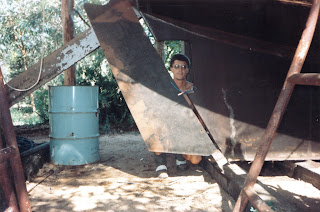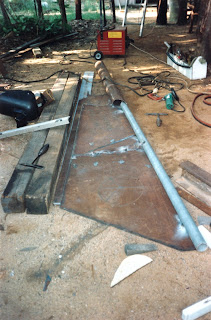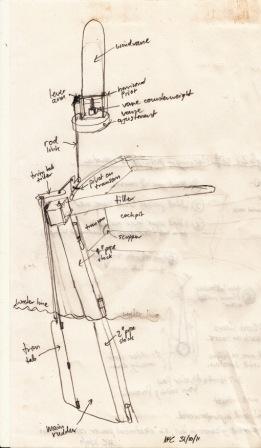A Masonite template was fitted in position to make sure that things would line up and look OK.
Then 2" pipe forms the leading edge of the blade, 4" pipe was aligned and welded on above this. The rudder design is hollow with 2 sides made of 3mm plate, these were shaped from the template. One rudder side was attached to the 2" stock
2 triangular internal frames were tacked into position and the bottom plate fitted. (pic below)
The other side plate was fitted followed by the small curved top plate.
Following MIG weld up, the rudder stock head (tiller socket) and self steering trim tab were fabricated as per plans. 3 Pintle and gudgeon pairs were then fitted and the whole rudder assembly aligned before the gudgeon's were welded to the transom and keel base.
The almost finished rudder. The curved blade top can act as a step to get back on board. The trim tab gear is fitted to the aft edge of rudder blade.
The lower gudgeon and pintle. Protective keel extension below the rudder base.(Sorry pics on its side),
The rudder head, the main tiller hole was cut out of the transom. The trim tab tiller is on top, a 10mm rod is connected to the trim tab below, it runs inside a 19mm diam water pipe.
Below is a schematic diagram of the Wylo2s self-steering system
A removable horizontal axis wind-vane is usually mounted up high on the boom gallows. The vanes blade made from ply is usually removable, so it can be either stowed away when in port or replaced by a smaller storm vane when the wind gets up. It is horizontally swung as this generates better leverage and power than a vertical axis vane would. (It also swings in a smaller area.) A round fixable rotating drum is used as the base of the vane assemblage to align it to apparent wind direction.
The principle of operation.
When the yacht is sailing at speed on the desired course, the vane is aligned with the apparent wind direction.
Lever arms and push/pull rods transfer energy from the vane to the trim-tab on the aft edge of the rudder. So when the boat strays off course the vane tips over and the force turns the trim tab. The trim tab then applies hydrodynamic force (from sailing forwards) to turn the rudder in the correct direction to turn the boat back on course.
The system is rugged and dependable and works in most conditions and all points of sail. I'm not sure what the lowest wind speed - hull speed are that it will operate. As it is wind direction dependent, the system is used when well off-shore. A sudden wind shift will alter the boats course. So when close to the coast line or other navigational hazards like reefs, the vane is disengaged and hand steering used.
The vane self steering uses no electrical power as an electronic auto-helm would. It is simple, homemade and repairable by crew with the right tools.
Commercial vane systems cost allot more. A popular type is the pendulum-servo, which also uses wind and hydrodynamic force to amplify the rudder turning force.
An electrical auto-helm draws considerable current if connected direct to the tiller-rudder. It would work well if motoring long distance. It might be possible to connect a very small electrical auto-helm in reverse to the wylo2's trim tab tiller?, but i haven't heard of anyone trying to do this as yet..




